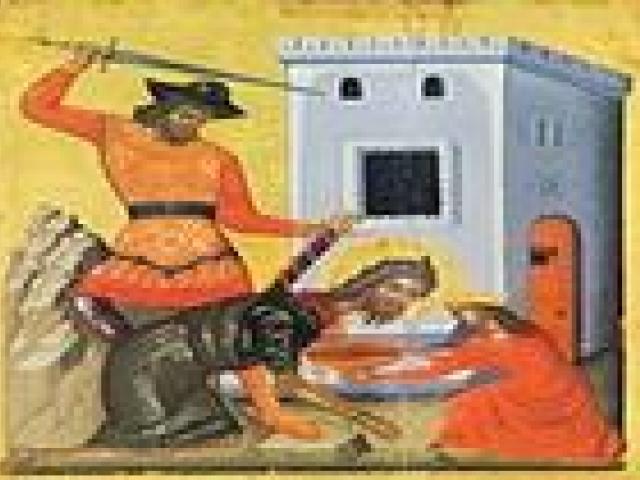Second Century: Persecution and Faith
Orthodox Church in America-OCA -
The Apostle Peter’s writes: “ In this you greatly rejoice, though now for a little while, if need be, you have been grieved by various trials, that the genuineness of your faith, being much more precious than gold that perishes, though it is tested by fire, may be found to praise, honor, and glory at the revelation of Jesus Christ.”
The second century Christian Community was severely attacked and persecuted. This proved to strengthen faith as well as require the church to defend the truth that was handed down to them by Christ and the Apostles.
The Persecutions
The second century saw the further development of the Christian faith and the greater persecution of the Church by the Roman imperial authorities, for whom Christianity was an “illegal religion.”
The Christians were criminals in the eyes of the Romans, not only religiously, but also politically. They transgressed the laws of the state because they refused to honor the earthly emperor as king, lord, and god, which was required of them as members of imperial society. They prayed for the civil authorities and gave “honor to whom honor is due” (Romans 13:1-7), but they refused to give the earthly king the glory and worship which was due to God, and to His Christ, alone. Thus the Roman law declared: It is not lawful to be a Christian.
One of the first witnesses to the Christians which we have in secular writing, is found in the second century correspondence between Pliny the Younger and the Emperor Trajan, who ruled from 98-117. This correspondence reveals that Christianity was indeed proscribed, and that though Christians should not be sought out and were innocent of the gross charges against them, such as the sacrifice of children and the eating of human flesh (a misunderstanding of the Eucharist which was conducted in “secret meetings”), the Christians nevertheless were to be executed if, when seized, they refused to give up their faith.
The persecution of the Christians in the second century was largely local, conducted according to the zeal of the local imperial authorities. Nevertheless, the persecutions were widespread and the Christians were generally hated even by the most tolerant and openminded of the Roman rulers. They were hated mostly for what was considered their stubbornness and intolerance due to their exclusive devotion to Christ as Lord. They were persecuted also for what was considered to be the political danger which they brought to the unity of law and order in the imperial reign, particularly because of the increasing number of persons who were joining the Church.
Among the most famous of the Christian leaders and martyrs of the second century were the bishops Ignatius of Antioch (d.c. 110) and Polycarp of Smyrna (d. 156), and the philosopher Justin (d.c. 165). Each of these men who were killed for the faith left writings which, together with the Didache, the Letter to Diognetus, the letters of Clement of Rome, the Letter of Barnabas, the Shepherd of Hermas and the apologetic writings of such men as Athenagoras of Athens, Melito of Sardis, Theophilus of Antioch and the greatest of the second century theologians, Irenaeus of Lyons, all give a very vivid picture of the faith and life of the second century of the Church.
Defense of the Faith: Apologists
The most important developments in the second century, in addition to the persecutions and the growth of Church membership, were the defenses of the Christian faith against the false teachings, the so called apologies against the Christian heresies as well as against Judaism and paganism. There was also the development of Church doctrine and the beginnings of post apostolic theology; the establishment of the same basic church order in each local community led by its bishop, presbyters and deacons; the first foundations of the Christian liturgy and sacramental life completely separated from the Jewish synagogue; and the beginnings of the establishment of the canon of the holy scriptures of the New Testament Church.
At the end of the first century and at the beginning of the second century, many false writings about Christ were produced. These were the so called apocryphal writings (not to be confused with the Old Testament apocrypha), the so called pseudoepigrapha. These false writings carried the names of the apostles and introduced into Christian circles many fanciful and legendary stories about the childhood of Christ, the life of the Virgin Mary and the activities of the apostles.
Together with the pseudoepigrapha, there also appeared the false teachings of gnosticism, the Christian heresy which transformed Christianity into a kind of spiritualistic, dualistic, intellectualistic philosophy. The genuine Christians of the Orthodox faith had to contend with these false teachings. The result of their struggle was the production of the theology of the apologists, that is, those who defended the true faith and the original gospel of Christ. The result also was the teaching of apostolic succession in the Church, the doctrine that the genuine faith and life of Christianity is passed over from church to church, from generation to generation and from place to place, through the succession of the Holy Tradition of the Church in the consecration of bishops, whose teachings and practice is identical to each other and to that of the apostles of Jesus.
Another result was that the Church began firmly to establish exactly which writings belong to the holy scripture of the Church and which do not, their decision being based on the genuine apostolic testimony contained in the writings, and their use in the Church at the liturgical gatherings.
Church Order and Liturgy
In the writings of the second century apologists, martyrs, and saints, it is seen that each local Christian Church was headed by one bishop who presided over the Church, which was administered by the presbyters or elders, and served by the deacons. Thus Saint Ignatius of Antioch writes in his letters:
I exhort you to strive to do all things in harmony with God: the bishop is to preside in the place of God, while the presbyters are to function as the council of the apostles, and the deacons, who are most dear to me, are entrusted with the ministry (i.e., good works) of Jesus Christ. (Letter to Magnesians 6, 1)
Take care, then, to partake of one Eucharist; for one is the Flesh of our Lord Jesus Christ, and one the cup to unite us with His Blood, and one altar, just as there is one bishop assisted by the presbytery and the deacons, my fellow servants. (Letter to Philadelphians 4)
Where the bishop appears, there let the people be, just as where Jesus Christ is, there is the catholic Church. (Letter to Smyrneans 8, 2)
Saint Ignatius was the first to use the term catholic to describe the Church. It is an adjective of quality that tells how the Church is, namely, full, perfect, complete, whole, with nothing lacking in it of the fullness of the grace, truth and holiness of God.
In the Didache and the Apologies of Saint Justin and Saint Irenaeus, there are also descriptions of the Christian sacraments.
Baptize as follows: after explaining all of these points, baptize in the name of the Father and of the Son and of the Holy Spirit, in running water ... (Didache 7, 1)
Let no one eat and drink of your Eucharist but those who are baptized in the name of the Lord . . . (Didache 9)
On the Lord’s own Day, assemble in common to break bread and give thanks (i.e., the eucharist, which means thanksgiving); but first confess your sins so that your sacrifice may be pure.
However, no one quarelling with his brother may join your assembly until they are reconciled; your sacrifice must not be defiled. (Didache 14)






